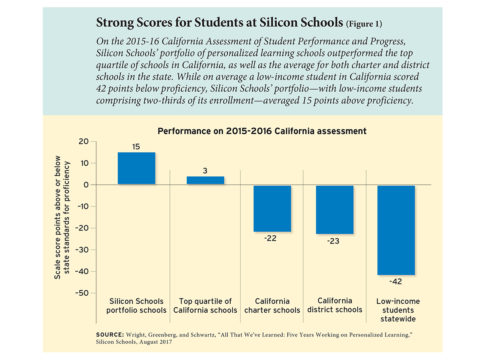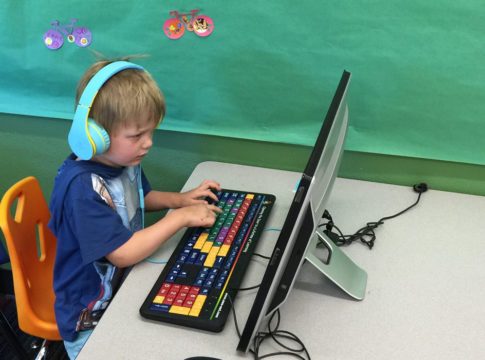In our day-to-day roles as a school system leader and the CEO of the nonprofit curriculum publisher Zearn, we focus on the moments of learning that occur between students and teachers—and on how personalized learning can make those moments richer and more frequent. Broadly, we define “personalized learning” as instructional models that help teachers support students through individualized pathways. Often, these models use technology.
As we work across systems, however, we hear two opposing views on personalized learning: either that it’s a once-in-a-lifetime opportunity to spread what works in education so that all students benefit, or that it threatens to reduce expectations and lower the quality of teaching and learning, especially for the neediest students. We agree that risk exists. If we don’t demand more of personalized learning, we could increase inequity in our K–12 system.
Digital technology in the classroom is here to stay, and in every other sector, that technology has increased productivity and, usually, engagement. But while professionals in other industries have defined requirements for their technological supports, as educators, we have yet to voice specific demands for personalized learning. As a result, we get offered a mixed bag of products, some of which show real promise, others of which cause great concern. This variation in quality muddles the conversation.
It is time to ask more of personalized learning. We believe that if we as an educational community clarify our needs, then developers will respond by creating significantly improved tools for teachers and students. To that end, here are two principles that we believe will help ensure that personalized learning drives equity and excellence for all students.
1. On-grade-level instruction for all students
In order to meet rigorous state standards, students must learn on-grade-level content—not the same below-grade-level content over and over again. Both research and practice show that, in terms of supporting unfinished learnings, teaching students on-grade-level content with important pedagogical modifications is the fastest way to help them reach on-grade-level understanding in math and language arts. Unfortunately, some personalized learning models have presented an oversimplified notion of “just-right” learning, with students receiving repetitive, below-grade exercises instead of the assistance they need.
For example, certain products might drop a 4th-grade student who struggles with an element of 4th-grade math to a lower grade level in which a particular concept was first taught. This “algorithmic choice” is based on a fundamental misconception of how coherent math works and how pedagogy can support ongoing learning.
Consider the following math problem:
4072
-2429
This is a 4th-grade subtraction problem that asks us to “regroup,” or break up one 1,000 to make ten 100s. (Colloquially, we often call this “borrowing.”) Fourth-graders might struggle here, particularly with the “0” in the hundreds place. If a student answers the question incorrectly, however, some personalized-learning programs might drop him or her back to where multi-digit subtraction was first introduced in the sequence of K–5 math instead of addressing the confusion over the “0.” In that case, the student would next see a problem like this:
21 – 13 =
This 2nd-grade problem lends itself to a counting or decomposition strategy, which might sound like this if verbalized: I know that 13 needs 7 to get to 20. One more makes 21. Seven and 1 are 8!
While doing subtraction problems in numerous formats is great, solving this early 2nd-grade problem does not help a 4th-grader get any closer to understanding the grade-level concept of regrouping, which he or she could learn by using place-value blocks or a place-value chart. This pedagogical approach is called the Concrete-to-Pictorial-to-Abstract (CPA) framework. CPA is grounded in brain science and breaks down math learning into three stages: (1) concrete, by physically manipulating objects; (2) pictorial, by building or drawing a model; and (3) abstract, by using only numbers and symbols. Students who struggle in the abstract stage, as our example student did in the 4th-grade subtraction problem above, can access the problem pictorially or concretely and still remain within the 4th-grade framework of regrouping.
Here’s how our example student, if struggling, might access this 4th-grade problem using a pictorial place-value approach:

CPA is just one pedagogical strategy to support students while allowing them to remain on grade level. When some students are able to continue working on grade level despite their difficulties while others have to go back through a previous grade level’s content instead, an inequality of outcomes is bound to emerge. Regardless, K–8 mathematics consists of a few big ideas that are unfolded over nine years, which allows us to trust that content will be revisited and further expanded.
In language arts, similar principles apply: dropping students to lower-grade reading levels cannot close gaps. Just as the CPA framework can be a pedagogical access point in math, topic-specific background knowledge can be an access point to grade-level reading. A child might be able to use background knowledge on the American Revolutionary War or dinosaurs, for example, to read grade-level vocabulary and sophisticated sentence structures, even when he or she may not regularly show an ability to read at grade level. In one experiment cited by cognitive scientist Dan Willingham, students were asked to read a passage about soccer. Students classified as poor readers in 3rd grade who had background knowledge about soccer were three times as likely to make accurate inferences about the passage as students classified as good readers who didn’t know much about the game.
Yet when students read below grade level, personalization often means finding any book at the grade level they “test” at. This practice goes against the research and exacerbates reading gaps. Instead of dropping students to a lower grade level, personalization should build vocabulary and background knowledge so students can access grade-level texts with their peers. The work of personalization means personalizing an appropriate, research-based pedagogical path, not an end point.
High and equal grade-level expectations for all students is the underpinning of an excellent and equitable educational system, and accessing grade-level rigor is often the most effective and efficient way to support students with unfinished learnings. Personalized learning, therefore, should scale this understanding, and as educational leaders, we need to examine the curricular and content choices made in our classrooms. We must hold personalization tightly to the belief that every student can access grade-level content in a way that is meaningful.
2. Instructional materials and practices that support reasoning, problem-solving, and communication work
When students engage in problem-solving work that asks them to reason and communicate their thinking, they perform better on high-stakes tests and become more prepared for post-secondary work.
In fact, one of the strongest predictors of graduating high school, going to college, and finishing a degree is the completion of algebra and one other rigorous high-school math course. It is not simply the number of math courses a student takes that seems to make a difference; it matters that one of them is algebra. Why might this be the case? Perhaps because algebra is the moment in the math sequence when many students move from arithmetic to symbolic language and abstract reasoning skills.
For more than 30 years, researchers have observed an interesting trend in American students when compared to the students from the highest-performing countries: those who are exposed to a math curriculum adequately emphasizing reasoning and problem-solving outperform their peers on the Trends in International Mathematics and Science Study (TIMSS) test. This finding was true both within and across countries, including within the U.S.
Research also tells us that students who get exposure to grade-level text and write consistently in response to that text see exponential growth in their reading and writing skills. Though this may feel counterintuitive given many educators’ inclination to teach students only at their tested reading levels, the data tells us otherwise. Students must experience the interaction and deep connections of reading and writing. Even more, they must engage daily with grade-level text, even when they are not yet reading at that level.
Across the country, rigorous standards call for an equal focus on procedural, conceptual, and problem-solving work. As personalized instructional resources enter into our precious instructional time, we cannot lower the bar. We need to ensure that a student’s instructional experience still retains the right balance of reasoning, problem-solving, and communication.
* * *
For personalized learning to do better, we must do better as educators. We need to demand excellence and equity of personalized learning and make our demands specific. We need to reject models of personalization that, in an effort to meet students where they are, effectively keep them from moving forward. If we do, personalized learning will help give all students on-grade-level instruction and more opportunities to reason, problem-solve, and communicate. More important, it will lead to more moments of learning between students and teachers—and distribute these moments more equitably throughout our K–12 system.
— Shalinee Sharma and Rebecca Kockler
Shalinee Sharma is co-founder and CEO of Zearn. Rebecca Kockler is Chief of Staff at Los Angeles Unified School District.





